How To Generate Trademark Ideas Using ChatGPT
Trademarks: they’re the emblem of a brand’s identity, a symbol that encapsulates what a company stands for, and a key asset in the competitive world of business. Trademarks play a crucial role in setting your products or services apart from the crowd, establishing trust among consumers, and protecting your brand.
In this blog post, we’re going to explore how to use the remarkable capabilities of ChatGPT to generate innovative and distinctive trademark ideas that can elevate your brand’s presence.
Chapters
Understanding Trademarks: Definition, Importance, and Types

A trademark is more than just a logo or a catchy slogan; it’s a legal symbol of your business’s unique offerings. Whether it’s a word mark, a logo, or a combination of both, trademarks are essential for safeguarding your brand’s image and reputation.
Trademarks come in various forms. From Nike’s iconic “swoosh” to the memorable phrase “Just Do It,” there are word marks, logos, and slogans. Each type serves a different purpose, and understanding these distinctions is crucial for creating a strong trademark strategy.
How Creativity Sets Trademarks Apart: Successful Examples
Creativity is the cornerstone of an outstanding trademark. The more creative and unique your trademark is, the more likely it is to leave a lasting impression. Brands like Apple, with its iconic apple-shaped logo, showcase the power of creativity in trademarks.
Think of brands like Coca-Cola, with its distinctive red and white script, or the golden arches of McDonald’s. These trademarks not only reflect creativity but also embody the essence of the brand, making them memorable to consumers.
How to Use ChatGPT for Trademark Ideas: Step-by-Step Guidance
1. Setting the Stage: Preparing for the Brainstorming Process
Before delving into AI-generated ideas, it’s crucial to set the stage for a productive trademark generation session. This initial phase involves preparing the necessary groundwork and defining the direction for your trademark project. Here, we’ll elaborate on each aspect of this preparatory process.
Initial Input and Context Setting
Start by providing ChatGPT with information about your brand, its values, and any specific requirements for the trademark. Remember that the more detailed and precise your input, the more tailored and relevant the trademark ideas you receive will be.
Prompt Examples for Initial Input and Context Setting
1. Brand Introduction: “Introduce my brand. We are a sustainable fashion company known for our eco-friendly materials and modern designs.”


2. Audience and Market:
“We primarily cater to tech-savvy millennials who value sustainability. Our market is highly competitive. How can we create a unique trademark that appeals to this audience?”
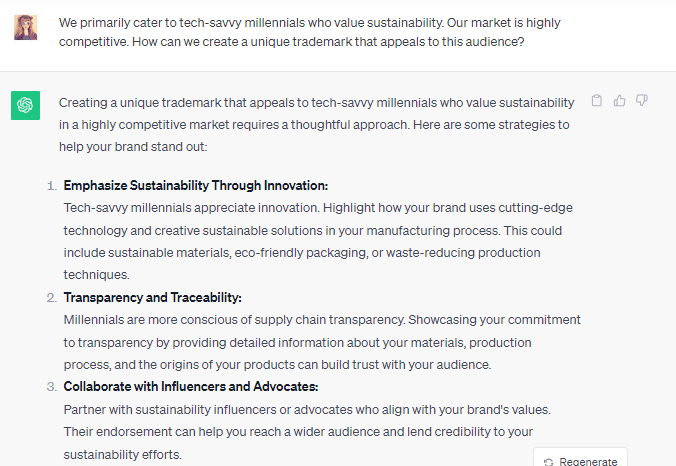
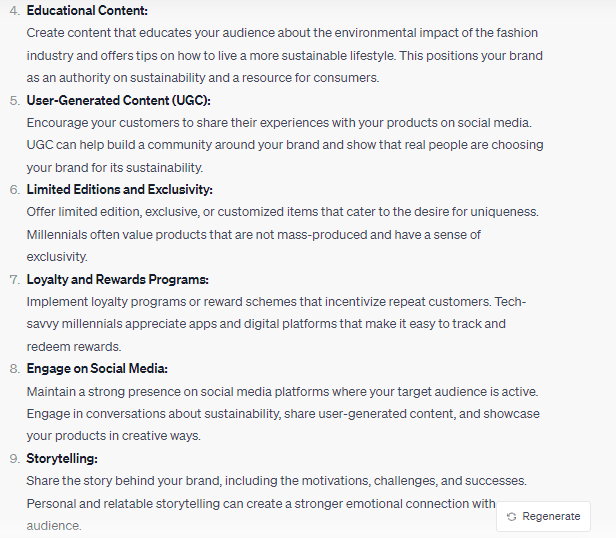
3. Brand Message:
“Our brand’s message is all about innovation and sustainability. We want our trademark to reflect these values. Can you suggest trademark concepts that embody these ideas?”
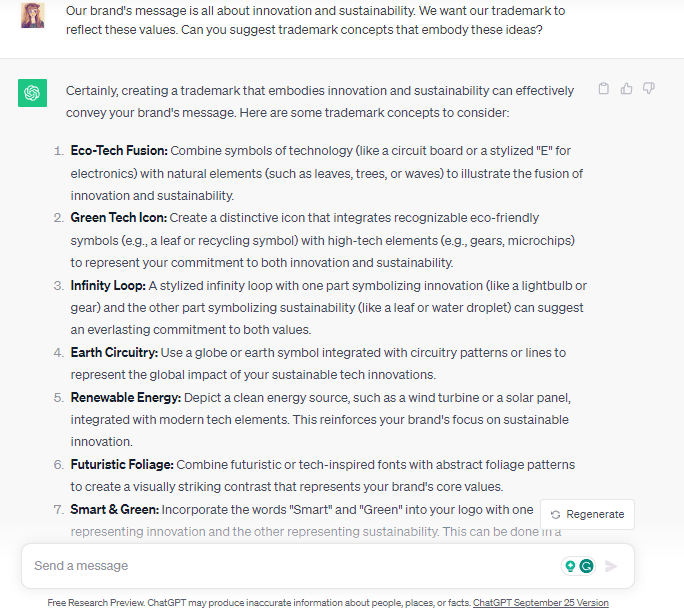
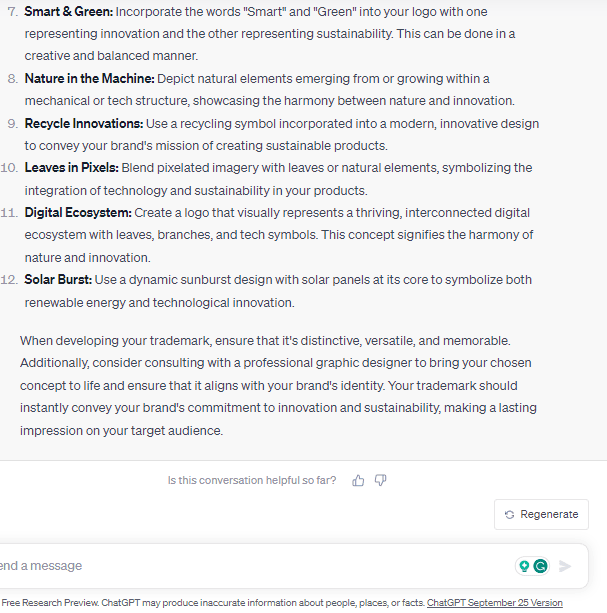
4. Competitor Analysis:
“We’ve noticed our competitors use nature-themed elements in their trademarks. How can we stand out while staying eco-friendly?”
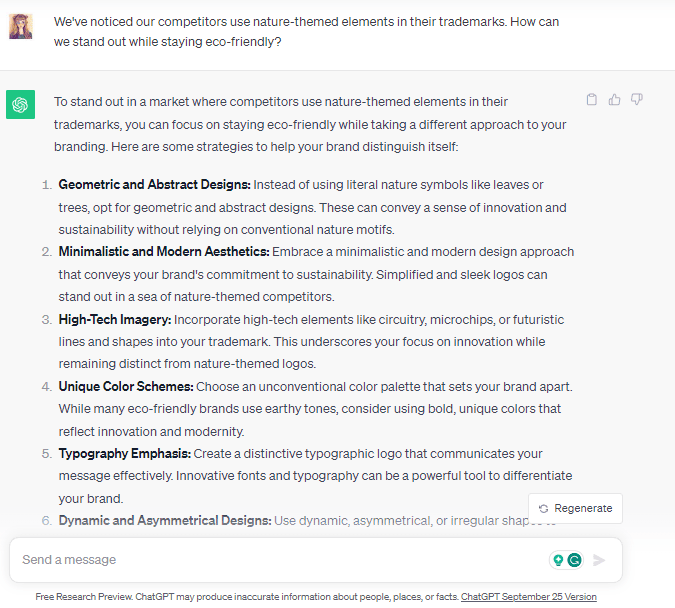
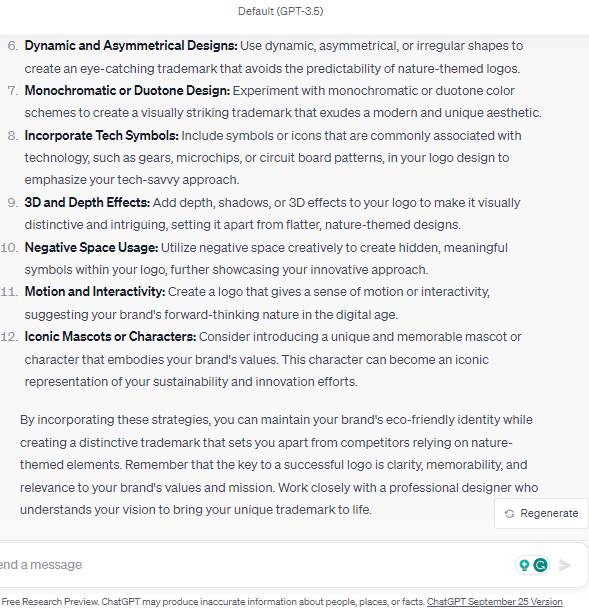
5. Trademark Type:
“We’re looking for a combination of a word mark and a logo. The word should be short and memorable, while the logo should depict nature and technology.”
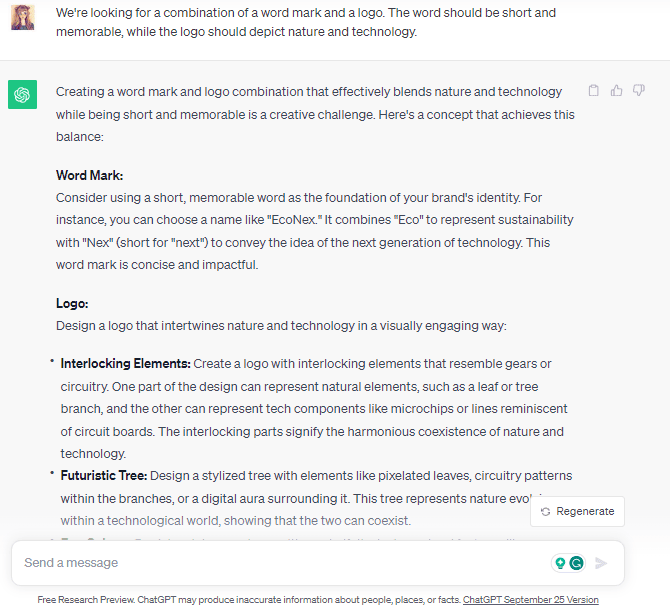
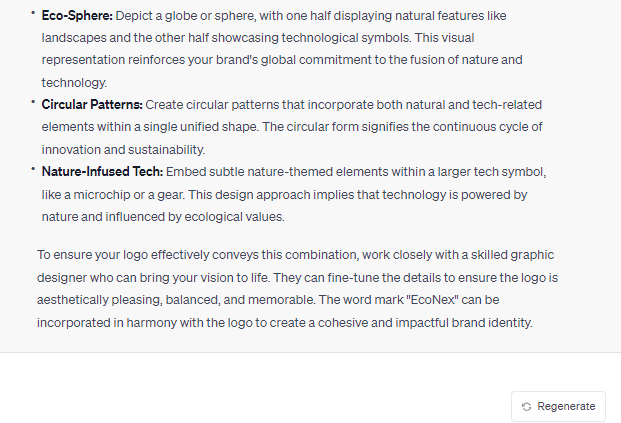
Iterative Question-and-Answer Sessions
Engage in a dynamic conversation with ChatGPT to explore different trademark concepts. Ask questions, seek suggestions, and evaluate the responses.
Prompt Examples for Iterative Question-and-Answer Sessions
1. Brainstorming Brand Values:
“Can you help me brainstorm a few keywords or phrases that represent sustainability, innovation, and modernity?”
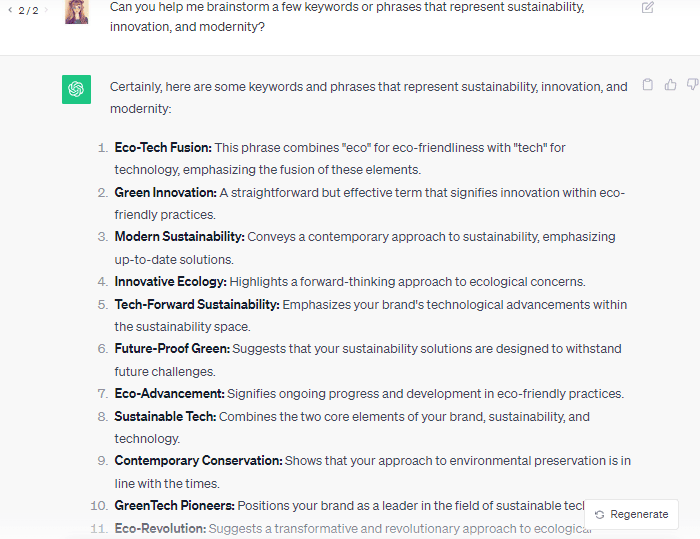
2. Logo Inspiration:
“I’m thinking of a logo with a tree merged with a circuit board. What other elements could complement this idea for a tech-savvy, eco-conscious audience?”
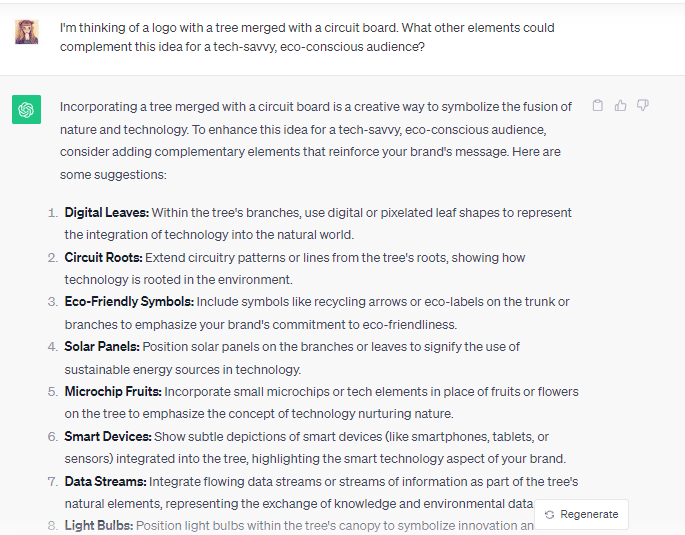
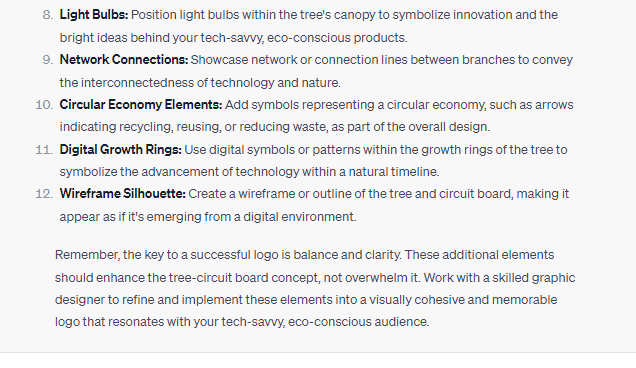
3. Tagline Ideas:
“We need a catchy tagline that goes with our word mark. Any suggestions that blend innovation and eco-friendliness?”
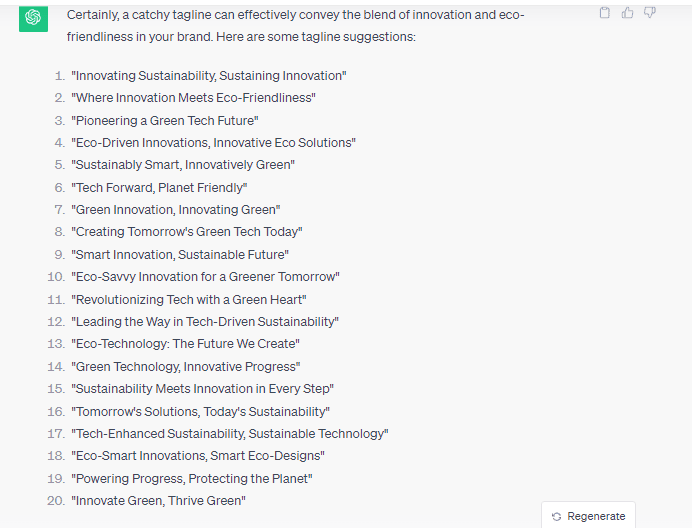
4. Feedback on Initial Concepts:
“I have a list of potential trademarks. Can you provide feedback and suggest improvements on each?”
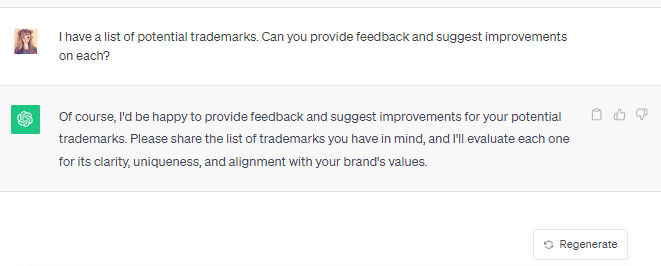
5. Exploring Symbolism:
“What symbols or metaphors could we use to convey the idea of a sustainable future through our trademark?”
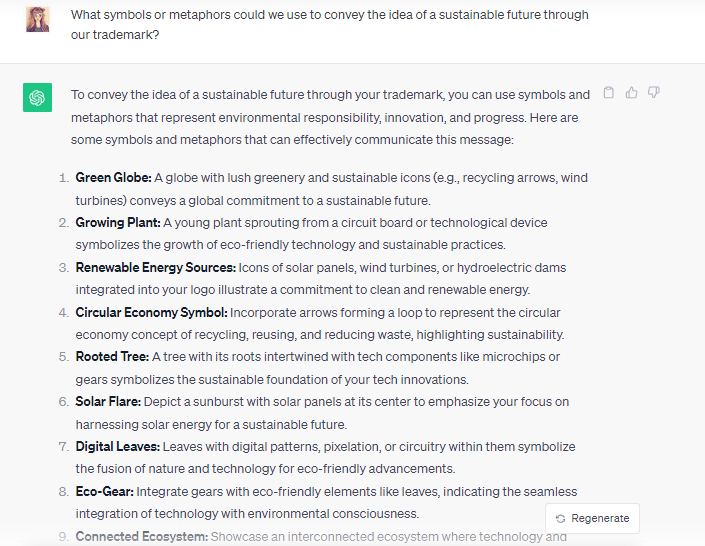
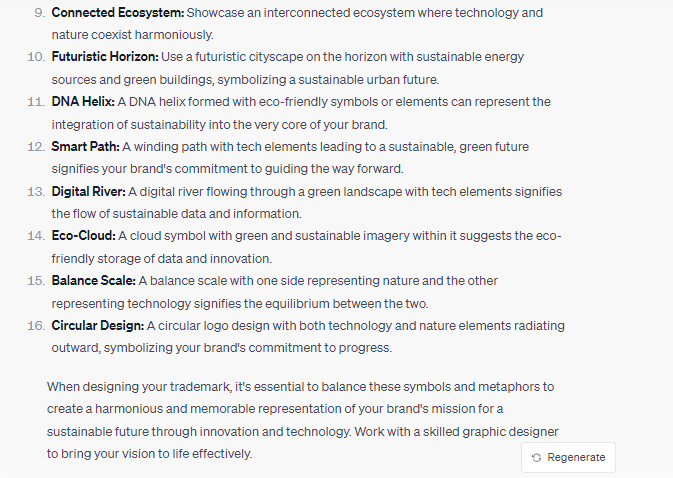
Refining and Selecting Ideas
After generating a list of ideas, carefully review and refine them to select the most promising options. You can ask ChatGPT to narrow down the choices and finalize the distinctive ones. But before you finalize, you should consider legal concerns or any potential trademark conflicts among the selected ideas. It might also be beneficial to consider the availability of corresponding .ai domains to enhance your brand’s online presence and alignment with technological advancements.
Using ChatGPT to Overcome Creative Blocks
Creativity can sometimes feel like a fickle muse that visits unpredictably, leaving you in the dark when you need inspiration the most. This is where ChatGPT comes to the rescue as an invaluable tool in your quest to overcome creative blocks.
ChatGPT is like having an ever-ready brainstorming partner at your disposal. It doesn’t get tired, doesn’t face writer’s block, and doesn’t run out of ideas. When you’re stuck and need a fresh perspective, ChatGPT is there to offer new angles and novel suggestions that your mind might not have considered.
Creative blocks often arise from the pressure to deliver something exceptional on a tight schedule. ChatGPT can help you generate trademark ideas on demand. Whether you need concepts for a product launch, a marketing campaign, or an event, you can turn to ChatGPT to provide quick and imaginative solutions.
Conclusion
The synergy of AI and human creativity holds immense promise in the realm of trademark generation. By embracing the power of AI, like ChatGPT, and combining it with your creative insights, you can craft trademarks that are not only legally sound but also distinctive and memorable.
FAQ
What are trademark ideas?
Trademark ideas are unique names, logos, slogans, or symbols that businesses or individuals use to distinguish their products or services from competitors in the marketplace and protect their brand identity legally.
Why are trademark ideas important for businesses?
Trademark ideas are important for businesses because the
y help establish brand recognition and reputation, prevent confusion among consumers, differentiate products or services in the market, and provide legal protection against infringement by competitors.
What are some characteristics of effective trademark ideas?
Effective trademark ideas are memorable, distinctive, descriptive or suggestive of the product or service, easy to pronounce and spell, legally available for registration, and capable of being used across various marketing channels.
How can businesses generate trademark ideas for their brands?
Businesses can generate trademark ideas for their brands by brainstorming unique names, symbols, or slogans that reflect their brand identity, values, and offerings, conducting trademark searches to ensure availability, and seeking feedback from stakeholders and legal experts.
What factors should businesses consider when selecting trademark ideas?
When selecting trademark ideas, businesses should consider factors such as brand positioning, target audience preferences, cultural and linguistic considerations, potential for expansion into new markets, and the likelihood of successful registration and protection.
What are some examples of successful trademark ideas?
Some examples of successful trademark ideas include iconic brand names like Coca-Cola, Nike’s “Just Do It” slogan, McDonald’s golden arches logo, Apple’s bitten apple symbol, and Google’s colorful lettermark logo, each representing a strong brand identity and market presence.
How can businesses ensure their trademark ideas are legally protected?
Businesses can ensure their trademark ideas are legally protected by conducting comprehensive trademark searches to check for conflicts, filing trademark applications with the appropriate intellectual property offices, monitoring and enforcing their trademark rights, and renewing registrations as required.
What are some common mistakes to avoid when developing trademark ideas?
Some common mistakes to avoid when developing trademark ideas include choosing generic or descriptive terms, neglecting to conduct proper trademark searches, infringing on existing trademarks, using geographical or surname terms without distinctiveness, and overlooking international trademark considerations.
How can businesses leverage trademark ideas to build brand equity and loyalty?
Businesses can leverage trademark ideas to build brand equity and loyalty by consistently using them across marketing materials and communication channels, creating memorable brand experiences for customers, and maintaining the integrity and quality associated with their trademarks.
What role do trademark ideas play in brand identity and marketing strategy?
Trademark ideas play a crucial role in brand identity and marketing strategy by serving as the foundation for brand recognition, differentiation, and communication, guiding brand messaging and positioning, and influencing consumer perceptions and purchasing decisions.
How can businesses ensure their trademark ideas are unique and distinct from competitors?
Businesses can ensure their trademark ideas are unique and distinct from competitors by conducting thorough trademark searches, analyzing industry trends, avoiding common industry clichés, and focusing on creating memorable and original brand elements.
What are some creative techniques for brainstorming trademark ideas?
Creative techniques for brainstorming trademark ideas include word association exercises, mind mapping, visual mood boards, exploring synonyms and wordplay, seeking inspiration from diverse sources, and collaborating with team members or creative professionals.
How can businesses test the effectiveness of their trademark ideas before finalizing them?
Businesses can test the effectiveness of their trademark ideas by conducting market research, gathering feedback from focus groups or surveys, creating mockups or prototypes, and analyzing consumer perceptions and reactions to different trademark concepts.
What role do trademark ideas play in establishing brand differentiation and positioning?
Trademark ideas play a crucial role in establishing brand differentiation and positioning by helping businesses stand out in crowded markets, communicate unique value propositions, and create emotional connections with target audiences through memorable brand elements.
How can businesses adapt their trademark ideas for global markets and cultural diversity?
Businesses can adapt their trademark ideas for global markets and cultural diversity by considering linguistic nuances, cultural sensitivities, and market preferences in different regions, conducting international trademark searches, and consulting with local experts or translators.
What are some resources available to businesses for conducting trademark searches and registrations?
Resources available to businesses for conducting trademark searches and registrations include online databases like the USPTO’s Trademark Electronic Search System (TESS), international trademark databases, trademark attorneys or agents, and intellectual property law firms specializing in trademark law.
How can businesses leverage trademark ideas to create cohesive branding across multiple product lines or services?
Businesses can leverage trademark ideas to create cohesive branding across multiple product lines or services by developing brand style guides, establishing consistent brand messaging and visual identity standards, and ensuring all brand elements align with the overarching brand strategy.
What are some considerations for rebranding or updating trademark ideas over time?
Considerations for rebranding or updating trademark ideas over time include assessing evolving market trends and consumer preferences, conducting brand audits to evaluate brand equity and relevance, communicating changes transparently to stakeholders, and preserving key brand elements that resonate with customers.
How can businesses protect their trademark ideas from infringement or misuse by third parties?
Businesses can protect their trademark ideas from infringement or misuse by registering trademarks with relevant intellectual property offices, monitoring for unauthorized use or dilution of their trademarks, enforcing their trademark rights through legal action when necessary, and maintaining proper trademark usage guidelines.
What role do trademark ideas play in brand storytelling and building emotional connections with consumers?
Trademark ideas play a central role in brand storytelling and building emotional connections with consumers by serving as visual and verbal cues that evoke brand narratives, values, and experiences, fostering brand loyalty and advocacy among customers.
Top AI Marketing Generators
Master the Art of Video Marketing
AI-Powered Tools to Ideate, Optimize, and Amplify!
- Spark Creativity: Unleash the most effective video ideas, scripts, and engaging hooks with our AI Generators.
- Optimize Instantly: Elevate your YouTube presence by optimizing video Titles, Descriptions, and Tags in seconds.
- Amplify Your Reach: Effortlessly craft social media, email, and ad copy to maximize your video’s impact.